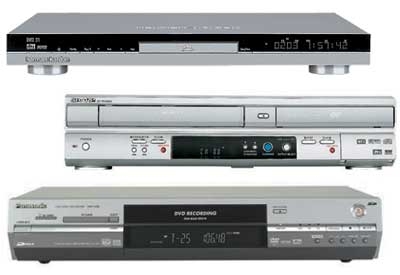How to Buy DVD Players & Recorders Page 2
DVD Player Basics Even if there's not much money left in your home theater kitty after you spring for big-ticket items like a TV and speakers, plan on spending at least $100 for a DVD player. And go for a familiar brand name: you'll have fewer headaches if it needs service, and simple things you'd normally take for granted - like the remote control and onscreen menus - are bound to work better. For a basic player, you're looking at two types: single-disc models, which handle one DVD or CD at a time, and changers, which let you store five or more discs - great for keeping the tunes flowing at parties or for all-night movie marathons.  A single-disc model (top) makes a good starter player, but if you're ready for DVD recording, consider a DVD/VHS recorder combo (middle) or a DVD/hard-disk combo (bottom).
A single-disc model (top) makes a good starter player, but if you're ready for DVD recording, consider a DVD/VHS recorder combo (middle) or a DVD/hard-disk combo (bottom).
Worthwhile UpgradesIf you have an HDTV, you'll get the best possible picture from DVDs by choosing a player with a progressive-scan output (see "The Lingo" for explanations of this and other key terms). Because these models send twice as much video information to the TV as standard models, you get a cleaner and smoother-looking picture. Most progressive-scan players cost only a bit more than standard ones, so there's no good excuse not to at least consider them. To reap the benefits of this technology, you'll need to use the player's component-video jacks. Most players don't come with component-video cables, so you'll have to buy them separately.
If your HDTV has either a DVI or HDMI input, another upgrade that's worth the extra money is a DVI or HDMI output. You'll generally get a more pristine picture with these connections because they keep the video signal digital all the way from the DVD to the TV, eliminating a whole stage of digital-to-analog-to-digital conversion.
Players with these connectors go even further by upconverting the standard video on a DVD to an HDTV format, either 720p or 1080i. What you're seeing isn't true high-definition - the player can't actually add detail to the picture - but you'd be surprised how close it looks to the real thing. (For more on this, see "Resolution Basics" on page 81.)
Music MattersDVD players do more than just play movies. They're fine CD players, too, and most new models can play MP3 music files that you've burned onto CD. But if you're really into downloading music, why not get a player that can also handle WMA files so you can listen to homemade discs of tunes you've bought online?
When shopping around for a DVD player, you'll run across models that feature DVD-Audio or Super Audio CD (SACD) playback. If you're wondering what the bleep those are, they're relatively new "high-resolution," surround sound music formats aimed mostly at audiophiles. They provide a music-listening experience that draws you in like a first-rate movie soundtrack. The catalog of SACD and DVD-Audio titles is minuscule, but there are some great recordings (see "Heavenly Surround" on page 103 and "Tracking Surround" on page 112 on the January 2005 issue of S&V).
Players designed to handle SACDs are incompatible with DVD-Audio discs, and vice versa, with the exception of some universal players that can handle both formats - and much more. To experience the studio-quality sound that DVD-Audio and SACD can produce, you'll need to connect the player's six multichannel analog audio output jacks to corresponding input jacks on your receiver (assuming it has them - most recent models do). Usually, these jacks are the only way to get the high-res signals into your receiver, but a handful of (expensive) players and receivers now feature digital SACD/DVD-Audio connections via a FireWire or proprietary cable.
Photos & NetworkingWhile the result might not be as thrilling as watching slideshows of your parents' vacations when you were a kid, some DVD players let you use your TV to view digital snapshots stored on disc in JPEG format. A few can also handle Kodak Picture CDs - a CD-ROM you can get instead of prints when Kodak processes a roll of film. Another photo-friendly option on some DVD players is a flash-media slot for your camera's memory card.
If you have a wired or wireless network at home, you can also find players with an Ethernet port that will let you retrieve images - as well as music files and even videos - from your computer's hard drive for playback in your home theater. More and more entertainment gear is taking advantage of this sort of connectivity, or "convergence," with networked computers.




























































